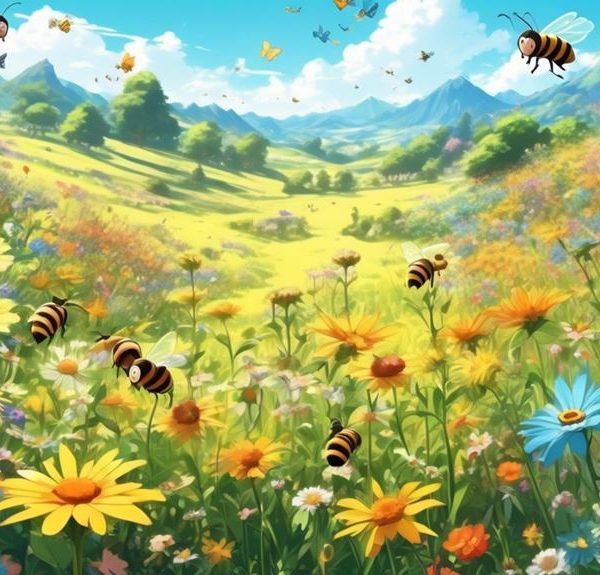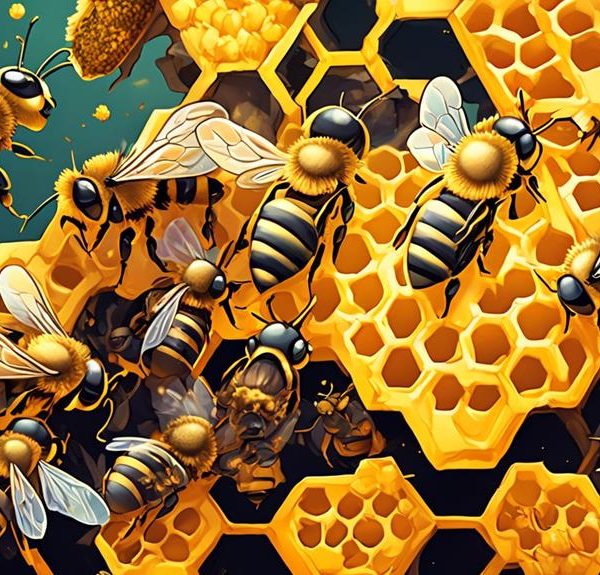Buzzing with curiosity about why bees prefer zinnias? Dive into a fascinating blend of biology, chemistry, and ecology to find out.
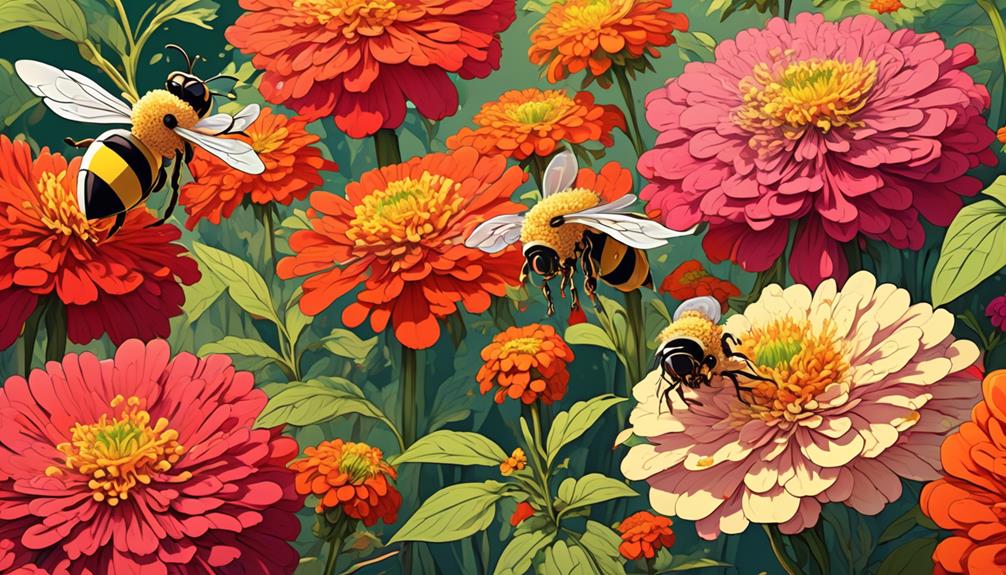
Why Do Bees Like Zinnias?
False
Key Takeaways
- Zinnias attract bees due to their vibrant colors within the ultraviolet spectrum, high sugar content in their nectar, easily accessible flower structure, and fragrant scent.
- Bees are more sensitive to blue and green colors, making blue-purple and yellow-green zinnias highly attractive to them.
- Zinnias continuously produce nectar throughout the day, providing a consistent food source for bees.
- Zinnias not only provide bees with nectar but also essential amino acids and pollen, contributing to their nutrition and overall health.
Understanding Bees' Attraction to Zinnias
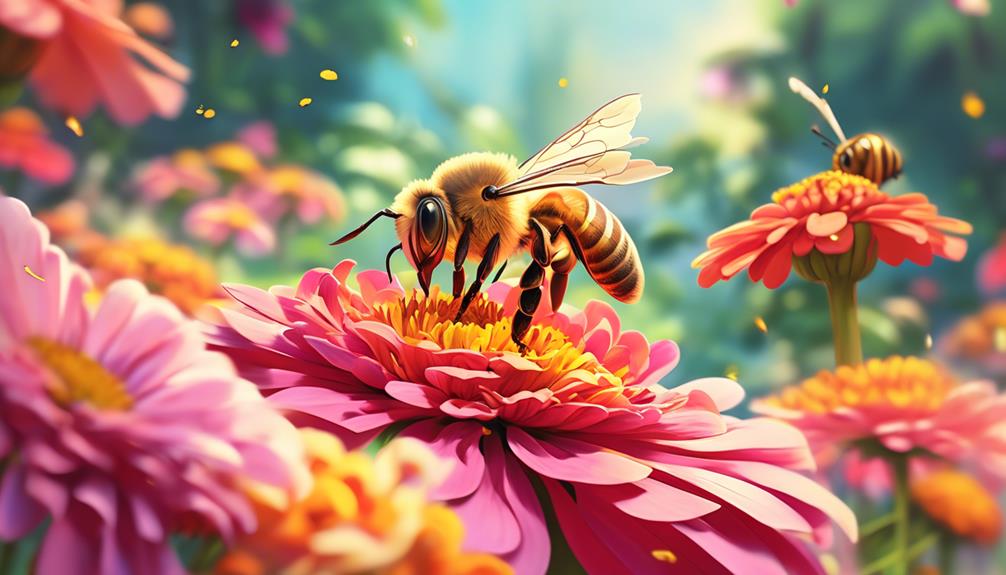
To understand why bees are drawn to zinnias, it's crucial to delve into the unique traits of these flowers that make them so enticing to these pollinators.
Zinnias, with their vibrant colors and distinct shapes, are visually attractive to bees. These pollinators can see into the ultraviolet spectrum, and zinnias' colors fall within this range, acting as a beacon for them.
Zinnias also produce a significant amount of nectar, an essential food source for bees. The nectar's high sugar content provides energy for their daily activities and is a primary attraction. The nectar and pollen are easily accessible due to the zinnias' open flower structure, which is inviting for bees.
Furthermore, zinnias emit a fragrant scent which serves as another attractant for bees. Bees have an exceptional sense of smell, and the unique aroma of zinnias can lure them from significant distances.
Lastly, zinnias are prolific bloomers, providing a consistent food source for bees throughout the season. When you plant zinnias, you're not just enhancing your garden's beauty; you're also creating a haven for these crucial pollinators.
The Role of Color in Bee-Zinnia Interaction
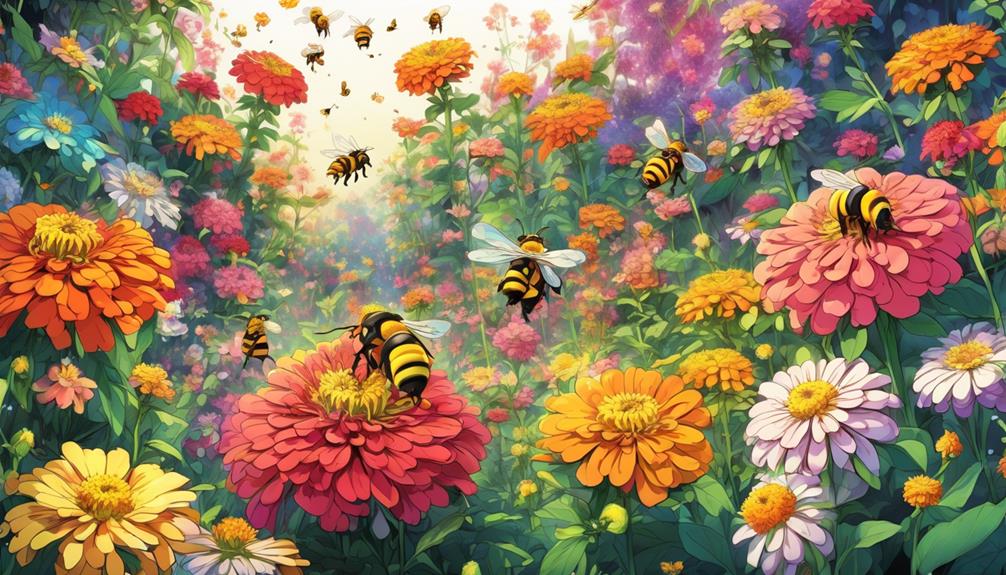
Diving into the spectrum of colors, it's fascinating to consider how bees perceive zinnias, as the bright hues of these flowers play a significant role in attracting these pollinators. You see, bees have a unique visual perception, they see colors differently from humans. They are more sensitive to blue and green, and can also see ultraviolet light, an ability humans lack.
This is where zinnias come into play. These flowers typically bloom in a wide range of vivid colors, including a variety of hues that fall into the blue and green spectrum. Consequently, they are highly visible to bees, and their bright colors serve as a beacon, signaling a source of nectar.
Let's take a closer look at how color influences bee-zinnia interaction:
Zinnia Color | Bee Attraction |
|---|---|
Blue-Purple | High |
Yellow-Green | High |
Red | Low |
As you can see, while red zinnias are vibrant to human eyes, bees don't perceive them as readily. Therefore, when planting a garden with pollination in mind, consider zinnias of blue, purple, yellow, and green hues to attract more bees.
Zinnias and Their Nectar Production

Beyond their vibrant colors, zinnias also have a noteworthy role in nectar production, making them a reliable source of food for their buzzing visitors.
You see, zinnias belong to the Asteraceae family, known for their capability to produce substantial amounts of nectar.
Their nectar, a sweet liquid produced by glands called nectaries, is rich in sugar. It's this sugar that provides a high-energy food source for bees. But it's not just about sweetness. The nectar of zinnias also contains amino acids, essential for bee health. This combination of nutrients makes zinnia nectar a potent attractor for bees.
Bloom size and shape also factor into nectar production. Zinnias, with their large, disk-like flowers, offer a broad landing platform for bees. This encourages prolonged visits, resulting in more nectar consumption and, importantly, enhanced pollination.
It's also crucial to note that zinnias, unlike some other plants, continuously produce nectar throughout the day. This consistent supply ensures that bees can rely on zinnias as a constant food source.
In short, zinnias' nectar production, along with their appealing coloration and bloom structure, explain why they're so popular with bees. It's a symbiotic relationship beneficial to both parties.
Zinnias: A Source of Bees' Nutrition

Continuing from the nectar production, you might wonder about the nutritional value that zinnias provide to bees. Well, zinnias are indeed a significant source of nutrition for these industrious insects. Specifically, they provide bees with two crucial nutrients: nectar and pollen.
Nectar, a sweet liquid, serves as the primary energy source for bees. It's rich in carbohydrates, mainly sucrose, fructose, and glucose. On the other hand, pollen, the second nutritional offering, is a protein-rich substance that also contains fats, vitamins, and minerals—all essential for bees' growth and development.
To emphasize, here's a brief comparison table:
Nutrient | Role in Bees' Nutrition |
|---|---|
Nectar | Primary energy source |
Pollen | Source of proteins, fats, vitamins, and minerals |
The Mutual Benefits of Bees and Zinnias
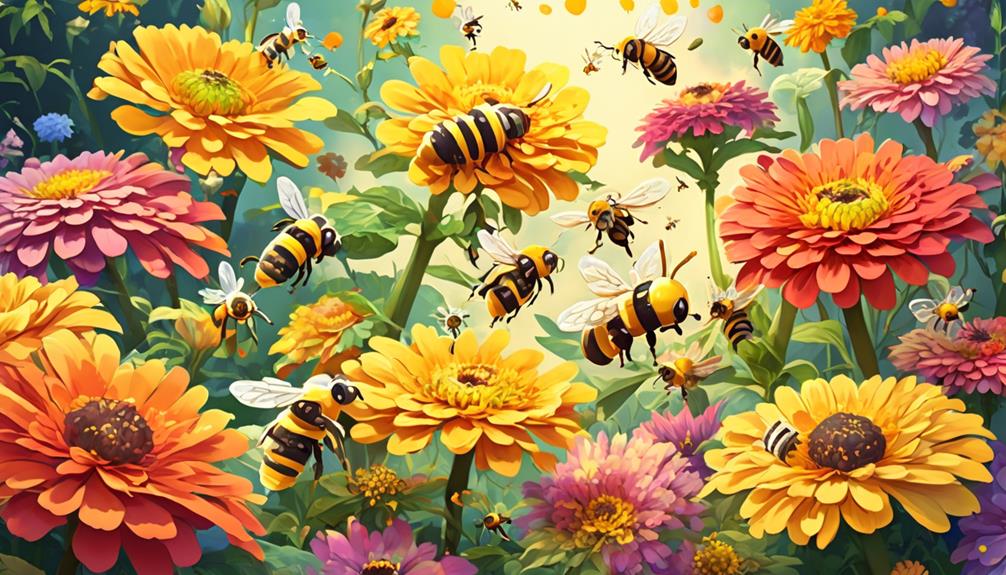
In exploring the symbiotic relationship between bees and zinnias, it's important to note that both parties reap substantial benefits. For bees, zinnias are a reliable source of nectar and pollen, essential for their diet and the production of honey. The vivid colors and sweet scent of zinnias attract bees, guiding them to a rich food source.
Now, let's consider the benefits for zinnias. You see, when a bee lands on a zinnia flower, pollen grains stick to its body. As the bee flits from flower to flower, these grains are transferred, facilitating cross-pollination. This process is crucial for the genetic diversity and reproductive success of zinnias.
But the benefits extend beyond individual zinnia plants. This bee-aided pollination contributes to the overall health and diversity of the plant ecosystem, fostering a vibrant and resilient environment. Furthermore, healthy zinnia populations attract more bees, amplifying these pollination benefits.
In a nutshell, bees and zinnias form a classic example of mutualism, a relationship where both species benefit. Understanding this symbiosis not only sheds light on why bees like zinnias, but also underscores the intricate interdependencies that sustain our biodiversity.
Frequently Asked Questions
What Other Flowers Besides Zinnias Are Popular Among Bees?
You're curious about which flowers, other than zinnias, bees favor. Bees are actually attracted to a variety of blooms.
Sunflowers, lavender, and cosmos are some they frequent. They're also drawn to flowers like marigolds, poppies, and wildflowers, especially those with bright colors and sweet nectar.
Native plants are another great choice as they've co-evolved with local bees.
Are There Specific Species of Bees That Are More Attracted to Zinnias?
You're correct to wonder if specific bee species have a preference for zinnias.
Honeybees and bumblebees, due to their size and ability to carry pollen, are particularly attracted to zinnias. These bees are drawn to the bright colors and rich nectar supply of zinnias.
However, it's important to note all bees have different preferences and habitat needs, so variety in your garden will attract a wider range of species.
How Do Zinnias Contribute to the Overall Health of a Bee Population?
Zinnias, with their bright colors and high nectar production, attract bees and contribute to their health by providing them with a rich food source. They're especially crucial during late summer and fall when other flowers aren't blooming.
By planting zinnias, you're helping to boost bee nutrition and immunity, which in turn supports the overall health and survival of the bee population.
Are There Certain Times of the Year When Bees Are More Attracted to Zinnias?
Yes, there are.
Bees are most attracted to zinnias during the warm, summer months when these flowers are in full bloom. This is because zinnias are a rich source of nectar and pollen, which bees need for their survival.
So, when your garden is bursting with zinnias in the summer, you'll likely see a significant increase in bee activity.
It's all part of nature's fascinating cycle.
Do Bees Play a Role in the Propagation or Reproduction of Zinnias?
Yes, bees play a crucial role in zinnias' propagation. As they move from flower to flower, they inadvertently pick up pollen on their bodies. When they land on the next zinnia, some of this pollen rubs off, fertilizing the flower.
This process, known as cross-pollination, is essential for the reproduction of many plant species, including zinnias. So, your garden's buzzing friends aren't just enjoying the zinnias; they're helping them thrive, too.
Conclusion
So, you see, bees are drawn to zinnias not just because of their vibrant colors, but also due to their rich nectar production.
Zinnias provide essential nutrition for bees, while bees help zinnias thrive through pollination.
Understanding this mutual benefit and the specific factors attracting bees to zinnias can aid in promoting bee-friendly gardening practices, enhancing both our ecosystems and aesthetic landscapes.

